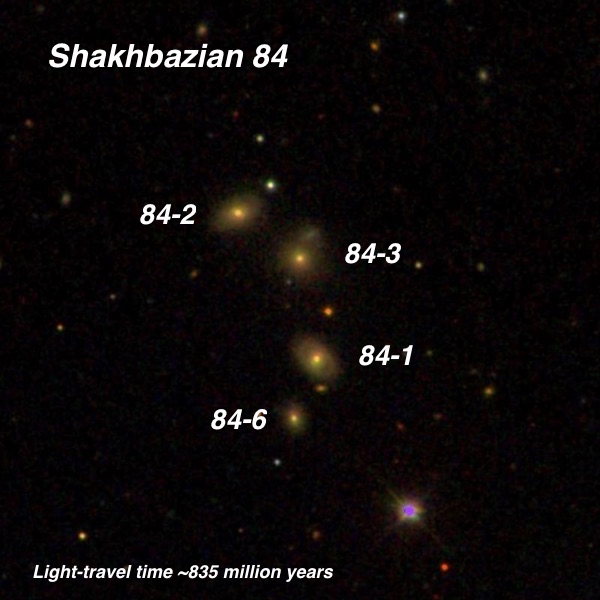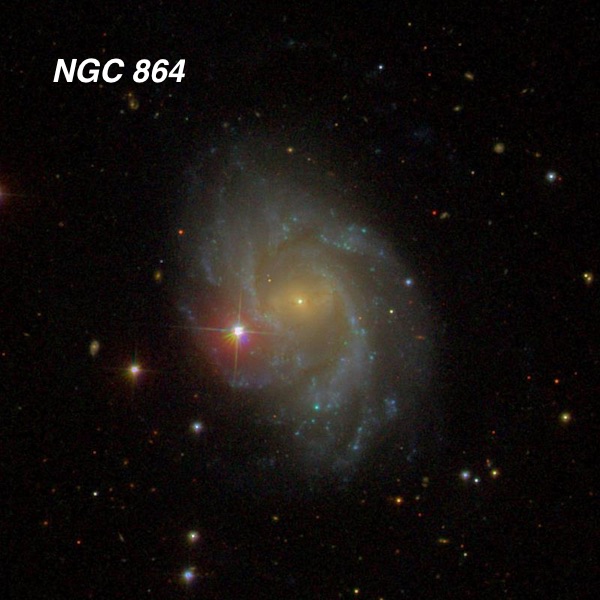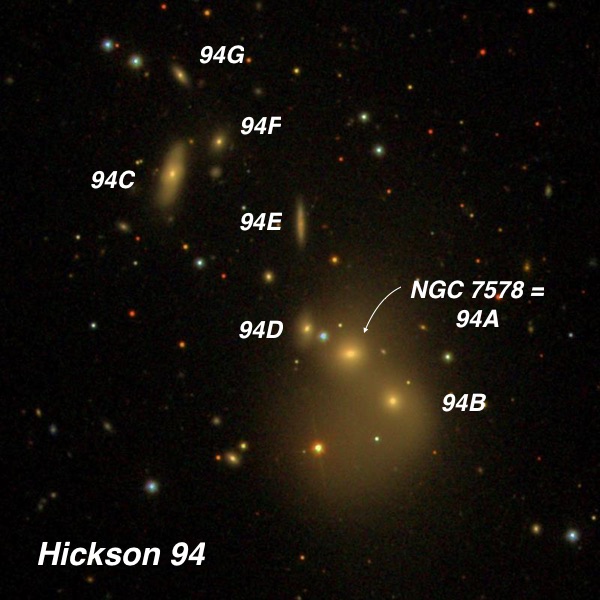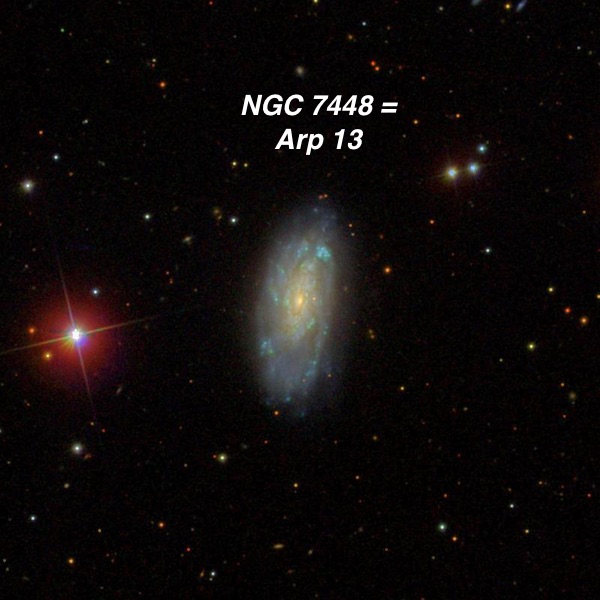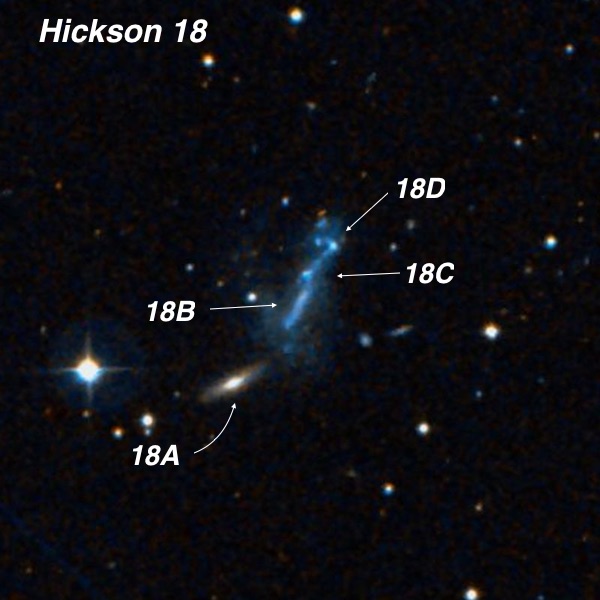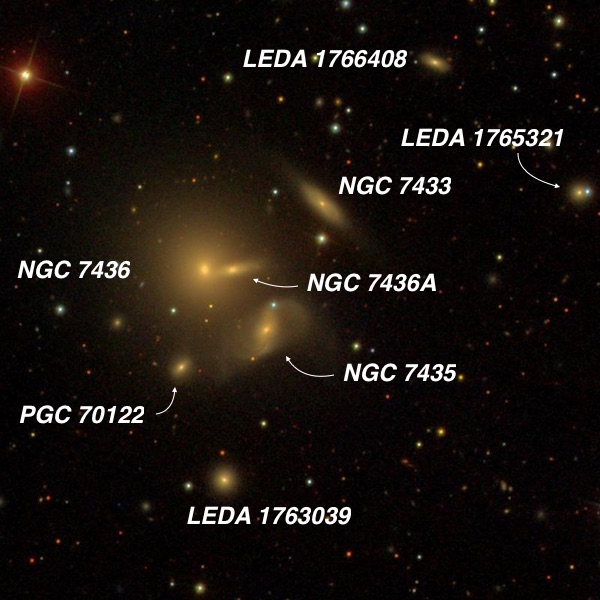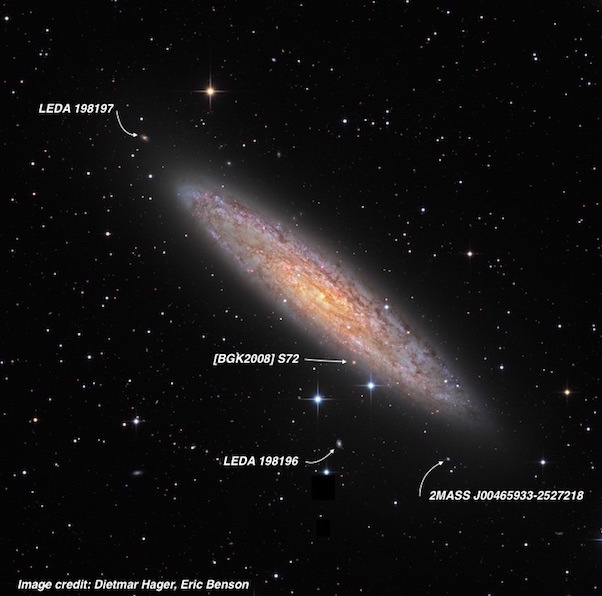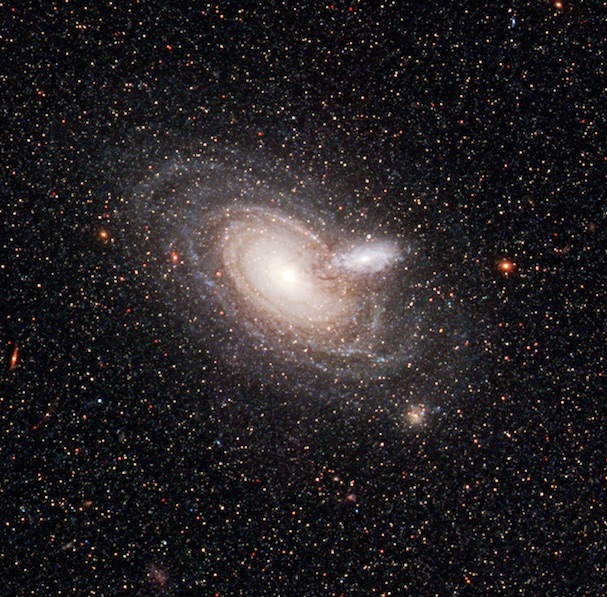OR: Fall Galaxies through a 48-inch!
by Steve Gottlieb
|
Over the October new moon period, Howard Banich and I spent four full nights (plus one clouded out) observing with Jimi Lowrey on his 48-inch in Fort Davis, Texas. His observatory is up the road from the Prude Ranch, the site of the Texas Star Party, and just down the road from McDonald Observatory on Mount Locke. His zero expansion Astro-Sitall mirror is a 48.8 inch f/4 (4.8 inches thick) and even with 28 holes cored out of the back still weighs 715 lbs. No, this scope is not portable. With a 16-foot focal length, viewing is often done up a serious climb on the ladder, but once you’re up there, the mesmerizing views suck you into the eyepiece and you’re not aware of the dizzying height. With fairly long evenings, we covered scores of objects from bright showpieces such as Most of the labeled images are from the Sloan Digital Sky Survey (http://www.sdss.org/) with identifications culled from NED (https://ned.ipac.caltech.edu/), HyperLeda (http://leda.univ-lyon1.fr/) and SIMBAD (http://simbad.u-strasbg.fr/simbad/). Hickson Compact Group (HCG) designations are from Paul Hickson's list of 100 compact galaxy groups, published in 1982. A list of the better HCGs is at hicklist.htm, along with identification charts and descriptions. Many additional Arps are covered in detail at www.astronomy-mall.com/Adventures.In.Deep.Space/peculspr.htm. The Shakhbazian Compact Groups of Galaxies (Shkh) is a catalogue of 377 compact groups of compact galaxies found on the Palomar Sky Survey prints between 1973 and 1979 by Armenian astronomer Romela Shakhbazian. These galaxies are smaller and fainter than the HCGs and generally require at least an 18-inch to view. Finally, the complete Hickson and Arp catalogues can be downloaded in Excel format at catalogs.htm. — Steve Gottlieb |
|
NGC 278 is high surface brightness spiral in Cassiopeia. Although face-on, it’s difficult to distinguish the individual arms as the dust lanes seems to snake across the galaxy slicing them into thick sections. We used 610x and 813x to try and resolve structure. The galaxy was extremely bright, large, with a squarish halo ~1.4' diameter. The center was very well concentrated with an intense round core that increases to the center. Sections of the two main thick spiral arms were visible, particularly along the north and south portion of the halo. Slightly darker lanes outline the inside of the arms. The inner arm sections are only noticed as subtle brighter patches. A well defined, small knot is on the east side of the halo [25" from center] and a second small knot is on the northeast side [23" from center]. These two star-forming complexes are catalogued as X-ray sources in NED. I also noted a third object at the NE edge, but at this position on the HST image is a very faint star.
Halton Arp placed this double system in his category of “Wind Effects”. This refers to the diffuse tidal plumes seen in IC 196, the larger member of the pair. These galaxies lie
in Aries at a distance of roughly 155 million l.y. The small galaxy Using 488x and 610x, IC 196 appeared bright, large, very elongated but irregular 5:1 ~N-S, ~2.0'x0.4', well concentrated with a small, round bright core. A fairly thin long arm
or tail extends due south from the core and then curls southwest towards IC 195 is fairly bright, moderately large, sharply concentrated with a bright, elongated 2:1 core NNW-SSE and highlighted by a stellar nucleus. The halo or spiral arms are very low surface brightness and extend 5:2 NW-SE, ~1.0'x0.4'. A distracting 15" pair of mag 10.4/12.7 stars lies 2.3' W.
Arp 284 is a pair of interacting galaxies NGC 7715 and Using 610x, NGC 7714 appeared very bright, moderately large, with an unusual irregular structure, ~1.2' diameter. This deformed, interacting Wolf-Rayet galaxy is dominated by an extremely bright stellar nucleus (starburst activity). A short bar-like central region is elongated NNW-SSE. A curved arm bends sharply west on the south end of the "bar" and contains a very small knot (southwest of the nucleus). A second arm, which appears to consist of a series of HII knots on the SDSS, begins on the northwest end of the "bar" and extends a short distance northeast. A low surface brightness halo appears as a hazy glow on the eastern side only [a tidal loop on the SDSS]. The western tidally stretched arm of NGC 7715 2' E heads towards NGC 7714 but doesn't form a complete bridge. NGC 7714 is located just 4' NW of mag 5.7 16 Psc and the bright star needs to be kept out of the field. NGC 7715 is fairly bright, moderately large, thin edge-on 6:1 WSW-ENE. This distorted galaxy is dominated by a small, bright elongated core ~20"x8" that increases to a star-like nucleus. Long stretched tidal arms or plumes extend WSW-ENE, ~1.8'x0.3'. The western "arm" heads towards the center of NGC 7714, but dims out just before reaching the halo.
Shakhbazian 84 Armenian (female) astronomers Romela Shakhbazian and Mina Petrosian discovered a number of compact groups of compact galaxies in the 1970’s. Shakhbazian 84 is a faint quartet spanning only 1.2' in a north-south curving chain. The members are roughly equally spaced. The group is ~5' NE of a mag 9.4 star and ~1' NE of a mag 14 star. I could only find the redshift on a single member (z = .062), with a light-travel time of ~834 million years. The group was examined at 610x and 813x. From north to south here are my notes.
Unfortunately, this striking two-armed barred spiral has a bright mag 10.7 star superimposed on the east side [44" ESE of center]. Even with this distraction it appeared bright,
fairly large, elongated 3:3 SW-NE, well concentrated with a bright core. The core extends into a weakly defined bar WNW-ESE. A long thin spiral arm is attached to the west end of
the bar and it curls gradually counter-clockwise to the south for nearly 90°, ending due south of the core [separation 1.2']. The second spiral arm is not as easily seen as it
begins just inside (west) of the bright star, which detracts from the view. This thin arm extends straight north, roughly at a right angle to the bar and merges into the halo on the
northeast side.
At 488x, NGC 7578B = HCG 94A was a fairly small prominent glow, sharply concentrated with a very bright core that gradually increased to the center and a low surface brightness
halo ~30” diameter. A mag 14.5 star is at the NE edge [17" from center].
Halton Arp placed this galaxy in his category "Spiral galaxy with detached segments”. The “detached segments” likely refer to the bright blue-green OB associations and HII regions in the SDSS image above. A 610x I found a very bright oval ~2:1 N-S, with knotty structure. The central portion is brighter along the major axis like a weak bar and in the center is a small, very bright nucleus. A bright, prominent knot, 10"-12" diameter, is just west of the northern tip of the galaxy and a weak knot is close east [by ~15"]. The northern half of the galaxy is generally brighter with a slightly mottled surface. The galaxy has a weak enhancement along the southwest edge of the halo [spiral arm] and a fairly faint knot is on the southeast side [40" SE of center]. Overall, the southern part of the halo has a lower, more uniform surface brightness.
Halton Arp classified the irregular blue mess as "Galaxies with Irregular clumps”. Hickson considered it a quartet with a single galaxy (
NGC 7436 is the brightest of 8 galaxies swarming nearby within a 4’ circle, including a very tight knot of NGC 7436, 7436A, 7431 and 7435. NGC 7436 appears to have an engorged halo, perhaps from previously snacking on some nearby companions that wandered too close. I seen the entire group in my 24” with some effort, but in the 48-inch they were all easy targets. Using 610x NGC 7436 appeared bright, moderately large, round, sharply concentrated with a very bright small core, increasing to a stellar nucleus. The halo has a much lower
surface brightness and contains
NGC 253 and companions I've viewed NGC 253 a number of times in the 48-inch and the view is always jaw-dropping as the mottled galaxy explodes into numerous bright knots, dusty patches, dark lanes and luminous star associations. These notes were from a previous view, as we were focused on the small companions to NGC 253 indicated above. Using a 21mm Ethos (232x), NGC 253 completely filled the 26' field. The central region of this starburst galaxy contains a blazing, nonstellar nucleus surrounding by an intense, elongated core with several bright patches around the periphery of the core (segments of the inner spiral arms). Just northwest and southeast of the nucleus are extremely bright sections of the core. Since the galaxy is only 12° from edge-on, many visible features extend parallel to the SW-NE major axis (PA = 52°). A dark lane running SW-NE parallels the core just off its northern side. Close northwest and parallel to this dust lane is a very bright, fairly narrow arm, extending ~3' in length. Another thin arm (also running SW-NE) is to the southeast of the core with a prominent, very thin section ~3.5' SW of center, just southwest of a superimposed mag 12.5-13 star. Three smaller bright patches surround a superimposed star ~2.5' NE of the nucleus. The brightest and largest of these patches is close southeast of the star. Further northeast the surface brightness lowers in the outer portion of the galaxy, but it still appears curdled and blotchy. Several bright stars are near the periphery including a mag 9.3 star 6.2' SW of center and a mag 11.6 star 3.8' W of center. A brighter patch is ~3.5' WSW of center is near the latter star. Additional luminous patches are further out on the southwest end. Four labeled small galaxies were tracked down. One (labeled [BGK2008] S72) is situated along the southern edge of the galaxy, just 4.5' SSW of center! It appeared fairly faint, very small, round, 12" diameter. Is this a dwarf companion to NGC 253 or a background galaxy that happens to lie on the same line of sight. Unfortunately, there is no available redshift I could find to settle this question. Another companion is LEDA 198197 has been the focus of studies with both the Hubble Space Telescope (HST) and the Very Large Telescope (VLT) at Paranal. First was a 2008 study titled "An Extended Dust Disk in a Spiral Galaxy: An Occulting Galaxy Pair in the ACS Nearby Galaxy Survey Treasury" (AJ, 137, 3000). The abstract mentions "The foreground disk system (at z = 0.06) shows a dusty disk much more extended than the starlight, with spiral lanes seen in extinction out to 1.5*radius, approximately 6 half-light radii. This pair is the first where extinction can be mapped reliably out to this distance from the center.” Here’s the HST image of LEDA 198197.
|
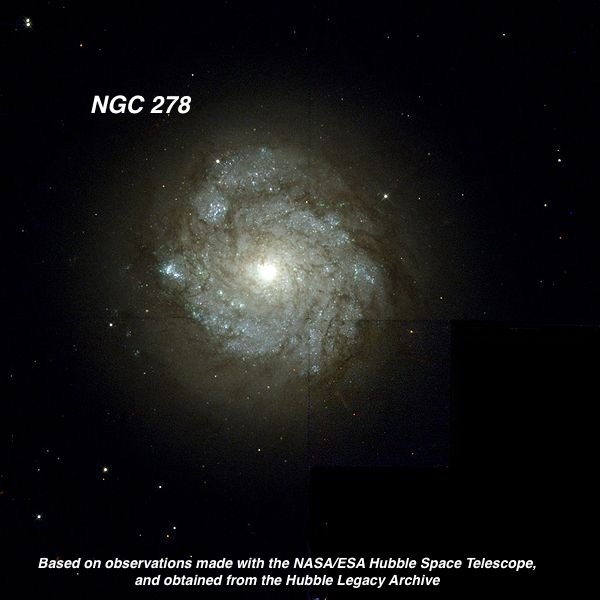
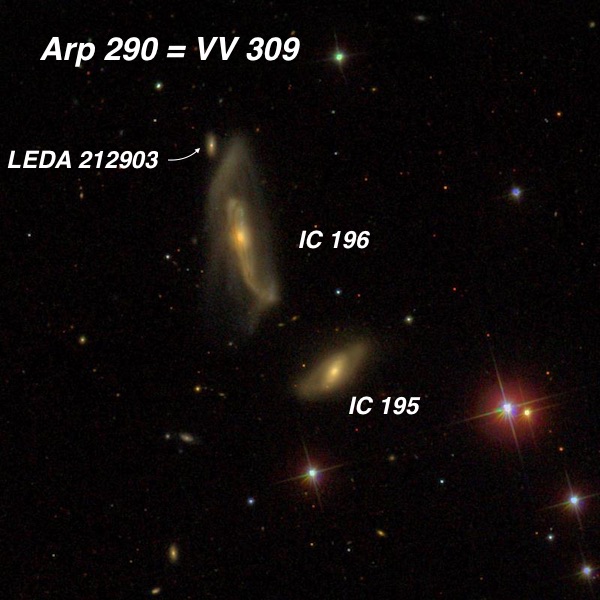
.jpeg)
